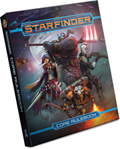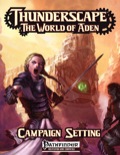Sign in to create or edit a product review. Many reviews have talked about what’s in the book, so I’m not going to do that. Rather, I’m going to mention what I like and don’t like. Likes (in no particular order):
Dislikes (in no particular order):
Conclusion:
Given the shifter’s stated aim of being simpler and this game, it makes me wonder if Pathfinder 2 is being worked on, and as a simpler game. That’s a worry to me, because people stuck by Paizo in the late 2000’s because they did not like the direction 4e went in, and wanted a variant of the 3.x rules. Yet, this is headed in that direction. If there had been a public playtest of this game, I’m pretty sure it would have ended up as “Pathfinder in space” instead of what it is. I like complexity, and I’d have liked this book to use the same rules as Pathfinder. Too much was packed into the book IMO, resulting in too many simplifications for my tastes. Because I know many people will enjoy the game, I am rating this a 2.5, rounding up for purpose of this platform. Fortunately, there may still be the following for Pathfinder:
James Jacobs wrote:
"The Iron Guard Field Guide" is a class sourcebook for the Thunderscape campaign setting. It provides a chunk of options for characters of the golemoid and thunder scout classes, and more. It is 36 pages long, and as well as all the crunch provided above, it includes background to the two classes and how they fit into the setting of Aden. Also provided are roleplaying tips for each class, and a table offering suggestions for how the character became a member of their class. In addition, there are two sample NPCs for each class, detailed at level 1, 6 and 12. The options presented in this book are fun and interesting. This is just as good as Saints & Sinners and Law & Destiny. If you like the other two class books, you'll love this. 
Thunderscape—Lost Lexicon, Part 1: Heart of the Machine (PFRPG) PDFKyoudai GamesOur Price: $14.99 Add to CartI’ve now read “Heart of the Machine”, part one of The Lost Lexicon adventure path for the Thunderscape setting… and I’m not sure I like it. It’s a 48 page PDF. The first part of it (Chapter 1) describes the city of Mekanus, its history and various districts. There is also a lot of detail about two possible factions that the PCs might join, or not. This section is excellent, and includes a map overview of the city with its sections. The second third of the book (Chapter 2) is devoted to Bounty Missions. While the town does have military forces, they are used against big threats and protecting the important/wealthy areas of the city. The PCs start the adventure by joining the Cogswheel Irregulars, who are semi-professional lawmen who do jobs to help deal with the problems that the authorities won’t. This section starts off by detailing how acceptable or not killing and looting is by the Cogswheel Irregular members. This is followed by several sample missions for a GM to use. This section ends with a four page mission generator; these cover bounty, security, courier, repossession and military missions. Chapter 3 begins to develop the plot for the adventure, with the characters performing a particular security mission; this covers 6 pages. Chapter 4 covers the adventure’s finale; the PCs should be 4th level when they attempt this section, which covers 8 pages. The last two pages includes a new monster and random encounter tables. This adventure feels very much like a “kit”. A GM will need to undertake serious preparation to ensure that it remains fun throughout; otherwise, it is just an endless collection a random missions, plus those encounters included in the book. There are no maps, aside from the map of Mekanus itself. Personally, I think that undertaking random missions for one class level (including the sample missions) would be enough to prevent too much repetition, and a series of mini-“dungeons” would work better. On the other hand, there could be say 2-3 missions with 8-10 or so encounters (PCs taking on a gang in a dilapidated house for example), several 3-6 encounter missions, and several 1-2 encounter missions, with encounters being roleplaying, traps, physical combat or whatever, and there should be maps. If such a thing is done, then the assault on the bad guys’ lair should also be beefed up to 8-10 encounters or it will feel underwhelming, and in any case, the final chapter should require 3rd level PCs and *just* take them to 4th level, ready for the next adventure. What would also really help is if GMs who have run or plan to run this adventure post the missions they create somewhere in a thread to help others. Sadly, the do-it-yourself element of Heart of the Machine does not make for a compelling or interesting first part of an adventure path, which is a shame, because Kyoudai books are normally fantastic. A GM could even start this campaign with other adventures beforehand to get the PCs to 3rd level, and start this adventure then, with the PCs arriving at the city as they reach 3rd level. "Law and Destiny" is a class sourcebook for the Thunderscape campaign setting. It provides a chunk of new options for characters of the arbiter and seer classes, and more. Scarman provides a helpful summary of what's included on the discussion page, but here’s a bit more info: Arbiter Maneuvers:
Seer Minor Prophecies:
Seer Major Prophecies:
Seer Master Prophecies:
It is 37 pages long, and as well as all the crunch provided above, it includes background to the two classes and how they fit into the setting of Aden. Also provided are roleplaying tips for each class, and a table offering suggestions for how the character became a member of their class. In addition, there are two sample NPCs for each class, detailed at level 1, 6 and 12. There is also a two-page spread which is spoilered, detailing the secret history of the Order of Seers; good stuff. The options presented in this book are fun and interesting. For example, piercing riposte allows an arbiter to ignore damage resistance of up to double his Intelligence modifier while making attacks of opportunity, while sage immunity allows an arbiter to add his Intelligence modifier to all saving throws versus magic. For seers, there are consume fate where the seer regains a use of second sight when an enemy is reduced to zero hit points while within the seer’s aura, and doombringer which increases the save DCs of auras that affect enemies by +2. All the new options increase the utility and fun of the two classes. As with Saints & Sinners, the stat blocks follow an unusual format in that the racial abilities, class abilities and favoured class bonuses are included in their own entries. They should really have been included in the special attack line, special quality line (and so on), as appropriate. The fluff in this book in excellent, even if you aren’t using the Aden setting itself, the information can help GMs and players better fit the two classes into their games. The new options are good as well. This book is well worth getting if you are a fan of the Thunderscape campaign setting, or just the class options. "Saints and Sinners" is a class sourcebook for the Thunderscape campaign setting. It provides a chunk of options for characters of the fallen and thaumaturge classes, and more. (Scarman provides a helpful summary of what's included on the discussion page.) It is 43 pages long, and as well as all the crunch provided above, it includes background to the two classes and how they fit into the setting of Aden. Also provided are roleplaying tips for each class, and a table offering suggestions for how the character became a member of their class. In addition, there are two sample NPCs for each class, detailed at level 1, 6 and 12. The options presented in this book are fun and interesting. In fact several of the fallen abilities made me chuckle, while the thaumaturge options greatly increase the potential versatility of that class. The channeler’s icons are a must have for thaumaturge PCs, IMO, as they act a bit like pearls of wisdom, allowing a character to reactivate a consumed aspect. Other points:
The corrupted claws ability gained at 16th level deals the same damage as at 4th level; I suspect that this should have been increased. The stat blocks follow an unusual format in that the racial abilities, class abilities and favoured class bonuses are included in their own entries. They should really have been included in the special attack line, special quality line (and so on), as appropriate. Overall, if you are a fan of the Thunderscape campaign setting, or just the class options, this book is worth getting. The two preceding reviews describe what's in the book. It's a great book, with a lot of interesting concepts in the races, classes, etc. As said elsewhere, the classes chapter is where the book shines. From the class chapter, I most like the entomancer and fallen classes, monk archetype, and samurai orders. The arbiter improved shieldwarden's stance ability seems to have been forgotten, so I'll make a stab at what it should say: Improved Shieldwarden's Stance (Ex) At 10th level, the arbiter gains a +4 dodge bonus to Armor Class (rather than +2) when using his shieldwarden's stance. He suffers only a -4 penalty to attack rolls when he attacks while using the total defence action. This ability otherwise follows all the normal rules and requirements of the arbiter's shieldwarden's stance ability and replaces the shieldwarden's stance ability. While not a fan of anthropomorphic races myself, what they did with the ferran race was well done- 3 body types (brute, predator, sneak)- and each of them chooses three Bestial Nature Racial Traits as well, to allow further customisation. Nice! One thing I found is that the font size is small. On the other hand, that fact must have reduced the book size, and considering that the cost of the book including shipping was $ pricy for me, I am grateful for that small mercy! Something I particularly like are the sidebars that describe how to use the material in your own games if they are not set in Aden. Also, the "chatty" parts which discuss particular rules elements, like the favored class bonuses and fallen paladins, are well argued. 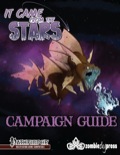
It Came From the Stars Campaign Guide (PFRPG)Zombie Sky PressNon-Mint/PDF Bundle Unavailable Backorder Print/PDF Bundle $25.99 Backorder Print Edition $24.99 Add PDF $9.99 Could have been better...The other reviews fully detail what’s in this book, so here is my opinion. I really wanted to like this book. There is a lot going for it. Nice art, some fun ideas, and the Bestiary monsters are NOT forced into one page per monster; they each get the space they need! Great! This book has flaws though, which makes me wonder if it was rushed. Some of the needed material was released in an additional book, called It Came From the Stars Extras (ICFTSE). Races
Tachiods are constructs (robots, even!), but are not given the construct type and robot subtype for some reason. Coalescents are a waste of space in its current format IMO. It is effectively a monster-class (per the 3.x Savage Species book), yet it is deeply underpowered. The class levels add nothing to the creature in humanoid form, except function largely as an aristocrat with no weapon or armour proficiencies other than simple weapons. A coalescent who gains spellcaster levels will therefore be severely penalised. A coalescent who gains martial class levels is also weakened. Who would play a (weaker) aristocrat 10/barbarian 10 or aristocrat 10/wizard 10 at 20th level? Noone. In swarm form, the coalescent gets no benefit from magic items other that rings, so at best a coalescent with Con 14 (assuming this is the character’s second best ability score) with the Ability Focus (distraction) feat and the vibrating swarm manifestation has a DC of 19 at 10th level; this is fine at that level, but it will never get better. Damage tops out at 5d6+1d8+1d4 (24.5 average) with two enhanced swarm attacks, and never gets better. The character also has to save against reverting to swarm form if in humanoid form and it takes damage. Really, the coalescent needs reworking into a template, but I'll move on. Classes
Starseed is a martial class with spellcasting abilities. It is the better of the two classes, and has a nice selection in its spell list. The psychic tendrils are natural weapons, although the book makes reference to two-weapon fighting. Natural weapons do not gain iterative attacks, although one stat block later in the book has the tendrils with iterative attacks. Worse than that lack of understanding: As a martial class, Str, Dex, and Con are important, but Int is necessary for spellcasting, and Cha for using tendril attacks. If the character has a void pearl (a new item presented later), the starseed can store extra void points, but the amount stored depends on his Wisdom modifier, thus making one of the MADest classes ever. Not good. This needs to be reworked so that it only needs 4 ability scores Int and the physical ones and the other mistake is corrected. Void Tech Items
Radiation: Gamma radiation should be changed to match that described in the Technology Guide, for consistency. Bestiary
Star Beasts: When talking about treasure, the word is hoard. When talking about large numbers of barbarians sweeping across the plains, the term is horde. Unfortunately, in every case the book talks about treasure hordes. How did nobody spot that? Adventures
Mockingbird: This is good, as you’d expect from Richard Pett. For some reason though, the save DCs for the alerting scream and spore abilities only take into account Con bonus, but don’t take into account the various creatures’ HD. Not good. That said, this is the best of the three adventures. Also be aware that the sandpiper has 10 attacks, which if all hit deal 85 average damage; a bit rough for a CR 8 creature! It’s probably best to reduce the number of attacks it makes to 4-5 instead. Fall of the Empyean Bulwark: Oh dear. This has many references to ICFTSE. Of course the save DCs for the alerting scream and spore abilities for the mocking in this adventure are incorrect, again (and the CR of the celestial buckler mockings are listed as CR 2, when they should be CR 1). There are various other stat block errors. Strangely, the adventure begins with the villain of the adventure asking the PCs to become involved; it would be better if they met the villain initially in the monastery at the same time as the warden, not as the initiator of the adventure. In another oddity, there are three good-aligned creatures determined to release the rest of the imprisoned aliens, most of which are nasty creatures. If they are good they’d surely realise caution would be the best approach to releasing the aliens, especially as one of the other released prisoners is an elder ooze. Conclusion
I have both the print and PDF versions. The PDF is in a horrible 3 column, landscape format, but needs to be in 2 column, portrait format for better readability and consistency with the print version. I strongly urge Zombie Sky Press to revise the PDF of It Came From the Stars, to not only fix the flaws within, but to include all the Extras material, and change the PDF format as noted above. Hopefully ZSS has at least broken even or made a profit already so that they can make these changes, and issue the new PDF version free to those who have purchased either print, PDF or both versions. Once they’ve done that, they could then consider a new print version for future purchasers. I rate this book at 2.5 stars, rounded up to 3 for purposes of this platform. If changes are made then I will change my star rating. I'm happy to discuss the issues with the ZSS if they want help. Edit: BTW, I hope this review doesn't come off as hostile. It's certainly not meant to be. 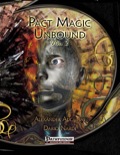
Pact Magic Unbound, Vol. 2 (PFRPG)Radiance House
Backorder
Print/PDF Bundle
Add
PDF
Backorder Print Edition $19.95 Awesomeness!This book is fantastic. :-) I'm happy to see that there are archetypes that are both pro and anti pact magic within the same classes (eg. cavalier, inquisitor). There are occasional editing errors, BUT: the only real drawback IMO is that with the increase in the number of spirits, it's getting harder to decide which are my absolute favourites (which will only increase in difficulty when volume 3 is released)! Shakes fist in good-humoured fashion! ;-) Seriously, well done Alexander and Dario. I very much look forward to volume 3! This book has great art, fluff, and layout. There are some fun concepts behind the monsters, and the author has clearly done his research (based on the Designer’s Notes). This is the first time I’ve written a one-star review, so I want to avoid being too harsh. Why one-star? There are many, many cases of errors in the stat blocks, and cases of bad design. For example, there are several cases where size bonuses or penalties are not applied correctly; cases where primary natural attacks are treated as secondary natural weapons (this is where the creature *only* uses natural attacks, not manufactured weapons as well); cases where skills are treated as fey skills, and hence receive the +3 trained bonus, when they should not. There are more errors but these are just examples. For bad design, here are some examples. There is the case of the CR 1 creature having an AC of 26; strange subtypes which are not explained anywhere in the text; having spellcasting at a CL of 16 for multiple spells when the creature is only CR 11; the case of a creature having Multiattack when it only has primary natural weapons; cases where the normal format is not followed, for example, with natural invisibility. All these errors are greatly disappointing. I have prepared a file which took many hours to note the errors and corrections needed, and will gladly forward it to Wolfgang. If or when the corrections are made, I will gladly change the review rating. This is excellent. Well worth the money! (EZG says everything that needs to be said, really!) 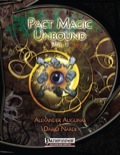
Pact Magic Unbound, Vol. 1 (PFRPG)Radiance HouseBackorder Print/PDF Bundle $19.95 Backorder Print $16.95 Add PDF $12.95 My thoughts on this!Yasha gave a more fully detailed review outlining what's in this book, and I generally agree with it. Here’s my thoughts on volume 1, hopefully to guide your thoughts on volume 2: I would love to give it 5/5, but I can’t. I can’t give it 3/5, either; that would be too mean IMO, so it gets a 4/5 from me. I should note that I thought the introduction of binders in 3.5 TOM was great. However, that had its flaws, which I’ll get to in a minute. Things missing from volume 1:
The thing I loathed about the 3.5 TOM binder was the class fluff. The TOM introduced this amazing class, but the fluff said “everyone hates you”. Which I thought was total B.S. What makes binders so bad that everyone hates them? An evil binder is no worse than an evil sorcerer, evil cleric, and so on. A good binder isn’t evil, yet people still hated them. I loathed that fluff.
The spirits. My favourites are Tyrant Cromwell, Ubro, and Serapith. It’d be good if the spirits in future books have just as much “oomph” as those. Some of the spirits just seem a bit random!!
Overall, I really like this book- don’t think otherwise. I just wanted to make the above points and hope that you’ll take them into consideration! This book is well worth buying! |




